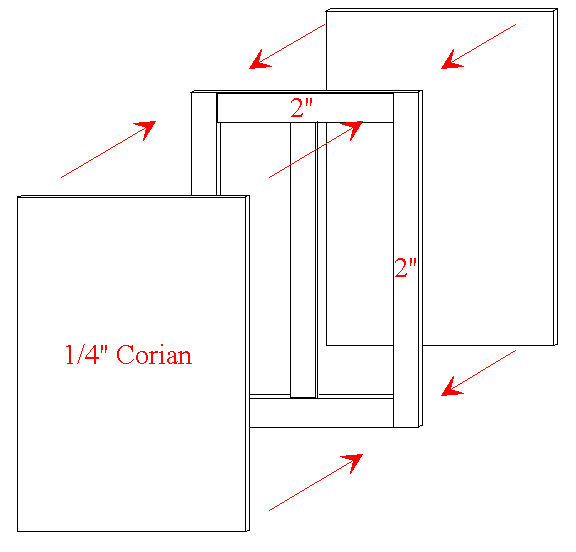Solid Surfacing for Vanity Doors
Advice on fabricating practical cabinet doors using solid surface material. vAugust 8, 2008
Question
I've been asked to do a job using Corian for slab doors. Has anyone had experience using this stuff for doors? It will be used on a large floating vanity.
Forum Responses
(Cabinetmaking Fourm)
From contributor J:
I assume you are talking about solid surface and Corian is the name brand? We use Corian and Avonite for countertops and sills. I can't imagine using it for doors - too brittle and hard to fasten to.
From contributor K:
I advise against it (more work than you imagine), but you can do it with 1/4" Corian. 3/4" solid Corian is too heavy. Reduce the weight by making 2" edges built-up to 3/4" for screws on hinge side and opposing side for pulls and top and bottom of door to lighten the weight, with an added center piece for support. Think of your average interior door - be sure to drill holes on top for uppers and on bottoms for lowers for gassing; 2" perimeter also allows for standard edging. Blum Inserta hinges (they don't use screws and use 4-5 per door), soft close hinges, bumpers and two more very important things...
1. A hefty price - this is a premium product and should command premium pricing (at least 3x your normal price for doors).
2. A disclaimer for the brittle nature of the product, and eventual minimal chipping over time that will occur.
If they still want to do this, then your real challenge will be if you are doing face frame - what to make it with (I suggest overlay color-coordinated painted wood frame to be able to screw into with 1/4" matching Corian). And if frameless, good luck long term with the weight pulling the screws out. One way to minimize this is with hardwood plugs (which can be replaced if necessary, should they weaken over time) for the screws to bite into.

Click here for higher quality, full size image
From the original questioner:
Thanks. I was skeptical about using this for doors and the weight was a major concern being added to the front of a floating vanity. I think I'll try to talk them out of it.
From contributor A:
I was at the mall tonight and all their bathroom partitions and doors are made of the stuff. Looks to me like the doors were two layers of 1/2". Heavy as all get out, but had large hinges. How big would your doors be?
From the original questioner:
These doors will be approximately 18"X20". The vanity will be 10 -12 feet long.
From contributor C:
We made Corian doors for a hanging vanity. We used 1/4" thick Corian siliconed to 5/8" PVC edgebanded melamine doors. 1/4" radius on 4 front edges. 4 years have gone by and no warp or weight issues. Customer loves it.
From the original questioner:
Thanks everyone! If they press me into it, the 1/4" with the frame or melamine inside sounds like the way to go.
From contributor L:
Don't laugh, but do a search on thefabricatornetwork.com for "squirrel fixings." If I remember right, they are made in England, and used to attach hardware to solid surface. I'd be careful of using wood plugs and screws - a little swelling and you have a crack.
From contributor K:
The wood plugs mentioned were for the cabinet wall of frameless cabs... with Blum Inserta hinges, you don't use screws when attaching the hinge to the Corian.
The comments below were added after this Forum discussion was archived as a Knowledge Base article (add your comment).
Comment from contributor E:
We have made Corian Cabinet doors. We use 1/2" Corian with a 1/4" x 2.5" frame around the back. Three Blum hinges are sufficient for most doors as the weight of the doors is about five pounds per square foot as opposed to three pounds per square foot. We replace the Blum screws with sheet metal type screws directly into the Corian. Pilot holes are drilled 1/32" smaller than the full diameter of the screw. For a stronger hold we use Hili-Coil inserts. I believe that the Heli-Coil inserts are at least as strong as the Squirrels, and easier to get and install.

